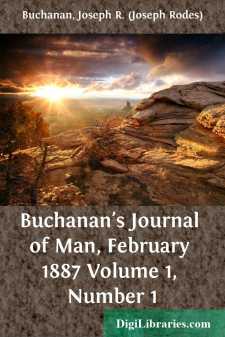Categories
- Antiques & Collectibles 13
- Architecture 36
- Art 48
- Bibles 22
- Biography & Autobiography 813
- Body, Mind & Spirit 142
- Business & Economics 28
- Children's Books 17
- Children's Fiction 14
- Computers 4
- Cooking 94
- Crafts & Hobbies 4
- Drama 346
- Education 46
- Family & Relationships 57
- Fiction 11829
- Games 19
- Gardening 17
- Health & Fitness 34
- History 1377
- House & Home 1
- Humor 147
- Juvenile Fiction 1873
- Juvenile Nonfiction 202
- Language Arts & Disciplines 88
- Law 16
- Literary Collections 686
- Literary Criticism 179
- Mathematics 13
- Medical 41
- Music 40
- Nature 179
- Non-Classifiable 1768
- Performing Arts 7
- Periodicals 1453
- Philosophy 64
- Photography 2
- Poetry 896
- Political Science 203
- Psychology 42
- Reference 154
- Religion 513
- Science 126
- Self-Help 84
- Social Science 81
- Sports & Recreation 34
- Study Aids 3
- Technology & Engineering 59
- Transportation 23
- Travel 463
- True Crime 29
Buchanan's Journal of Man, December 1887 Volume 1, Number 11
Categories:
Description:
Excerpt
The World’s Neglected or Forgotten Leaders and Pioneers.
Leif Ericson, the long-forgotten Scandinavian discoverer of North America, nearly five hundred years before Columbus, has at last received American justice, and a statue in his honor has been erected, which was unveiled in Boston, on Commonwealth Avenue, before a distinguished assemblage, on the 29th of October.
The history of the Scandinavian discovery and settlement was related on this occasion by Prof. E. Horsford, from whose address the following passages are extracted:
“What is the great fact that is sustained by such an array of authority? It is this: that somewhere to the southwest of Greenland, at least a fortnight’s sail, there were, for 300 years after the beginning of the 11th century, Norse colonies on the coast of America, with which colonies the home country maintained commercial intercourse. The country to which the merchant vessels sailed was Vinland.
“The fact next in importance that this history establishes is, that the first of the Northmen to set foot on the shores of Vinland was Leif Ericson. The story is a simple one, and most happily told by Prof. Mitchell, who for forty years was connected with the coast survey of the United States in the latitudes which include the region between Hatteras and Cape Ann. Leif, says Prof. Mitchell, never passed to the south of the peninsula of Cape Cod. He was succeeded by Thorwald, Leif’s brother. He came in Leif’s ship in 1002 to Leif’s headquarters in Massachusetts Bay and passed the winter. In the spring, he manned his ship and sailed eastward from Leif’s house, and, unluckily running against a neck of land, broke the stem of the ship. He grounded the ship in high water at a place where the tide receded with the ebb to a great distance, and permitted the men to careen her in the intervals of the tide, to repair her. When she was ready to sail again, the old stem or nose of the ship was set up in the sand. Thorwald remained a couple of years in the neighboring bay, examining sandy shores and islands, but not going around the point on or near which he had set up his ship’s nose. In a battle with the Indians he was wounded and died, and was buried in Vinland, and his crew returned to Greenland. A few years later, Thorfinn and his wife, Gudrid, set out with a fleet of three ships and 160 persons, of whom seven were women, to go to Vinland, and in two days’ sail beyond Markland they came to the ship’s nose set upon the shore, and, keeping that upon the starboard, they sailed along a sandy shore, which they called Wunderstrandir, and also Furderstrandir. One of the captains, evidently satisfied that they were not in the region visited by Leif and Thorwald, turned his vessel to the north to find Vinland. Thorfinn and Gudrid went further south and trafficked, and gathered great wealth of furs and woods, and then returned to Greenland and Norway.”
Prof. Horsford refers next to various geographic names on the New England coast which are of Scandinavian origin.
“What do all these names mean?...












